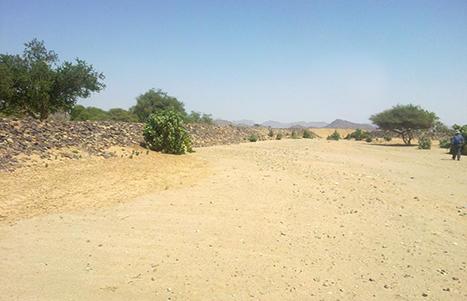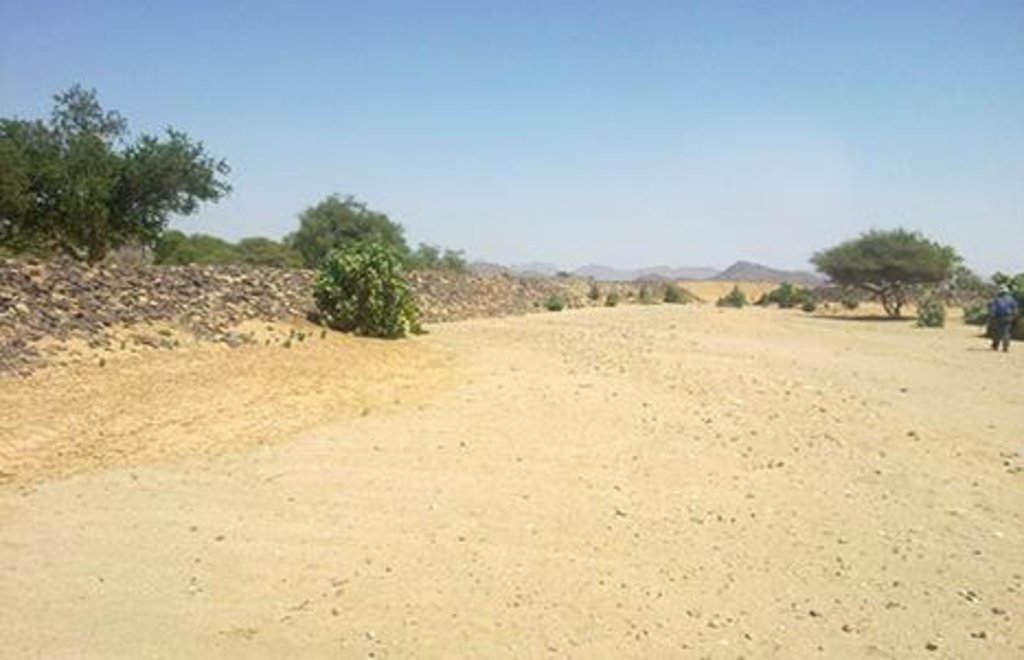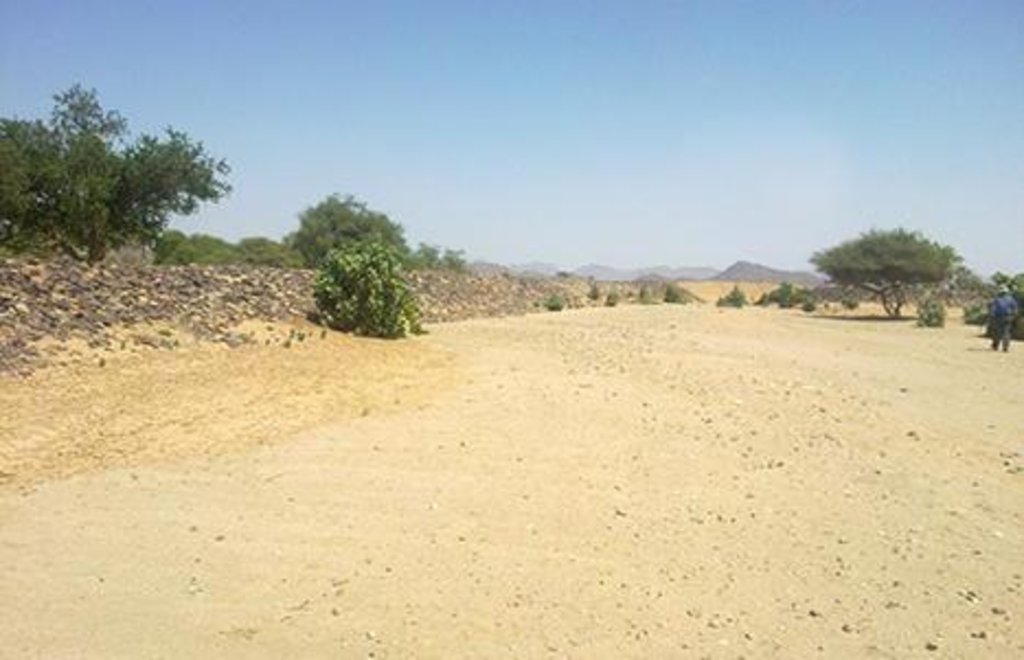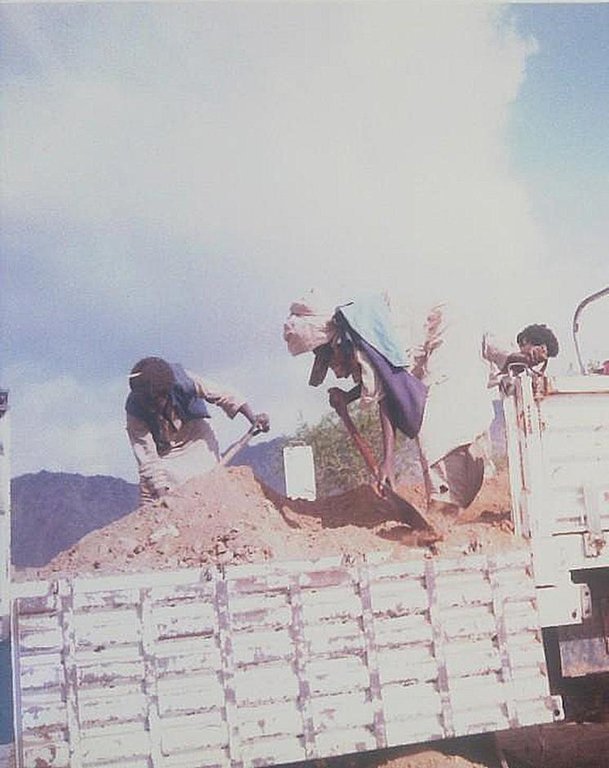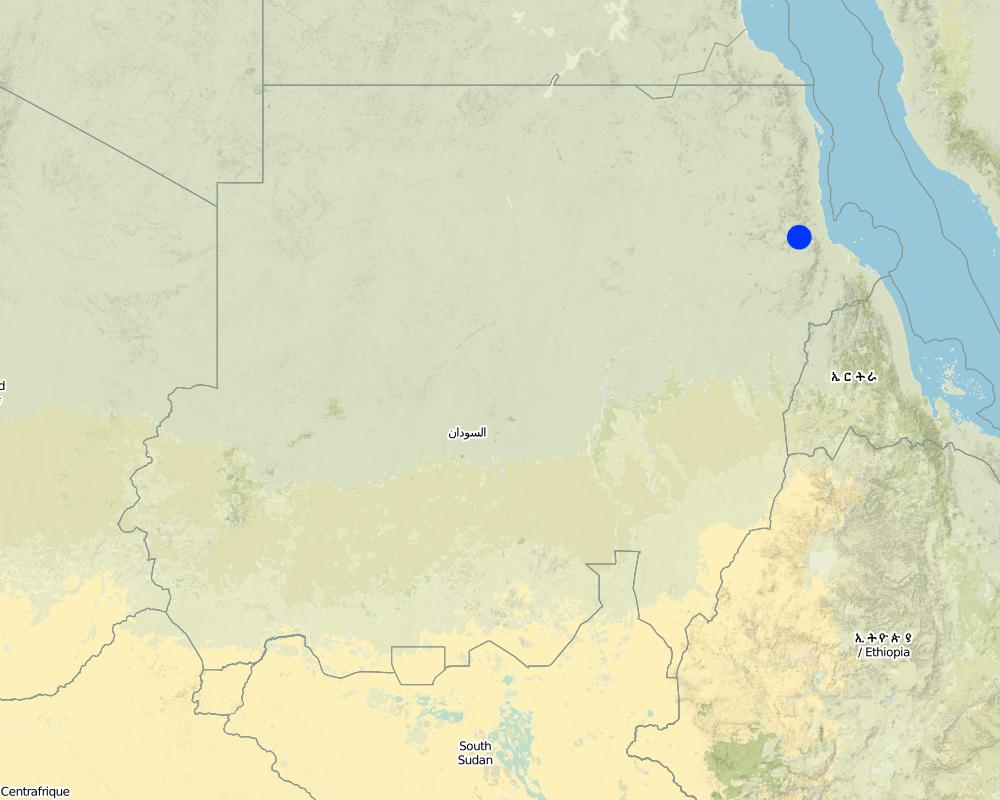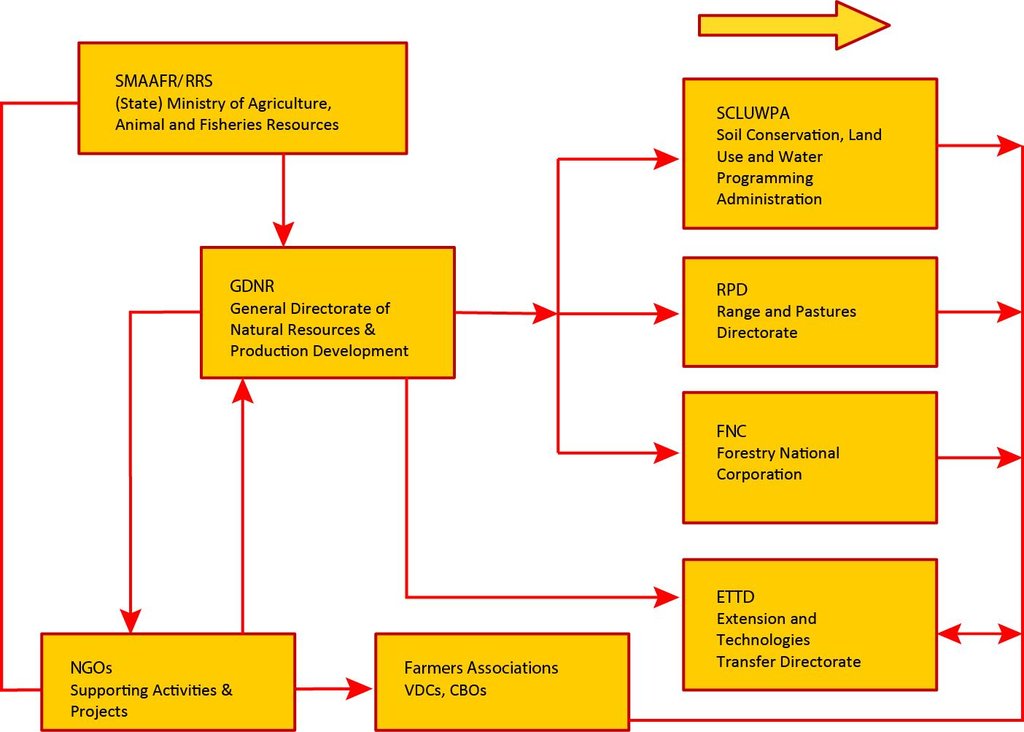Water Spreading (typical example from Hashatribab) [ប្រទេសស៊ូដង់]
- ការបង្កើត៖
- បច្ចុប្បន្នភាព
- អ្នកចងក្រង៖ Abdalla Osman Eisa
- អ្នកកែសម្រួល៖ –
- អ្នកត្រួតពិនិត្យ David Streiff
Sidud (Local Arabic) - Tarrit (Beja dialect) for earth dams
approaches_2543 - ប្រទេសស៊ូដង់
ពិនិត្យមើលគ្រប់ផ្នែក
ពង្រីកមើលទាំងអស់ បង្រួមទាំងអស់1. ព័ត៌មានទូទៅ
1.2 ព័ត៌មានលម្អិតពីបុគ្គលសំខាន់ៗ និងស្ថាប័នដែលចូលរួមក្នុងការវាយតម្លៃ និងចងក្រងឯកសារនៃវិធីសាស្ត្រផ្សព្វផ្សាយ
អ្នកជំនាញឯកទេស SLM:
អ្នកជំនាញឯកទេស SLM:
Gaiballa Abdelaziz
gaiballa@gmail.com
Sudan University of Science and Technology
ប្រទេសស៊ូដង់
អ្នកជំនាញឯកទេស SLM:
Dabaloub Sayed
+249 912913623
dabaloub@gmail.com
SCLUWPA Dirctor (1986-1995), now the ECDP Centre
Port Sudan
ប្រទេសស៊ូដង់
ឈ្មោះអង្គភាពមួយ (ច្រើន) ដែលបានចងក្រងឯកសារ/ វាយតម្លៃលើវិធីសាស្ត្រផ្សព្វផ្សាយ (បើទាក់ទង)
Soil Conservation, Land Use and Water Adminstratio (Soil Conservation, Land Use and Water Adminstratio) - ប្រទេសស៊ូដង់ឈ្មោះអង្គភាពមួយ (ច្រើន) ដែលបានចងក្រងឯកសារ/ វាយតម្លៃលើវិធីសាស្ត្រផ្សព្វផ្សាយ (បើទាក់ទង)
VU University Amsterdam (VU University Amsterdam) - ប្រទេសហូឡង់ឈ្មោះអង្គភាពមួយ (ច្រើន) ដែលបានចងក្រងឯកសារ/ វាយតម្លៃលើវិធីសាស្ត្រផ្សព្វផ្សាយ (បើទាក់ទង)
Sudan University of Science and Technology (SUST) - ប្រទេសស៊ូដង់1.3 លក្ខខណ្ឌទាក់ទងទៅនឹងការប្រើប្រាស់ទិន្នន័យដែលបានចងក្រងតាមរយៈវ៉ូខេត
តើពេលណាដែលទិន្នន័យបានចងក្រង (នៅទីវាល)?
15/05/2012
អ្នកចងក្រង និង(បុគ្គលសំខាន់ៗ)យល់ព្រមទទួលយកនូវលក្ខខណ្ឌនានាទាក់ទងទៅនឹងការប្រើប្រាស់ទិន្នន័យដែលបានចងក្រងតាមរយៈ វ៉ូខេត:
បាទ/ចា៎
1.4 ការយោងមួយ (ច្រើន) ទៅលើ (កម្រង) បញ្ជីសំណួរនៃបច្ចេកទេស SLM
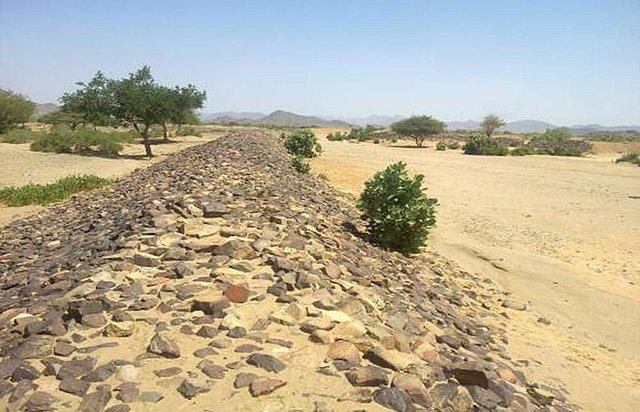
Water Spreading (typical example from Hashatribab) [ប្រទេសស៊ូដង់]
Water Spreading (or Spate Irrigation system) conducted through the construction of earth dam structures at the khor cross section.
- អ្នកចងក្រង៖ Abdalla Osman Eisa
2. ការពណ៌នាអំពីវិធីសាស្ត្រផ្សព្វផ្សាយ SLM
2.1 ពណ៌នាសង្ខេបខ្លីពីវិធីសាស្ត្រផ្សព្វផ្សាយ
Construction of water spreading system on khor and wadi with machinery jointly government and farmers in dam compaction and pitching.
2.2 ពណ៌នាលម្អិតពិវិធីសាស្ត្រផ្សព្វផ្សាយ
ពណ៌នាលម្អិតពិវិធីសាស្ត្រផ្សព្វផ្សាយ:
Aims / objectives: The main objective of the approach is to enable domestic land users cultivating crops (sorghum mainly) on a flood plain through construction of an earthen, stone-pitched barrier across the bed of a khor (stream). This earth dam serves to divert floodwaters onto their fields downstream. The approach is fully subsidized as the government provide technician and machines for the construction. Only some voluntary contribution from the beneficiaries is needed (for stone pitching). However maintenance support by the government is not provided later on.
This case study is typical of all those in the State. All are demand-driven...In addition the government supports farmers in rural extension e.g. preparedness, awareness, organization and mobilization, and to establish farmers VDCs (Village Development Committee) to guide the community in public works. Training and capacity building sessions in cultural extension are hold to develop crop raising techniques. The aim behind this is mainly to fill the gap of people’s deficiency in storage of crops such as sorghum and millet to maintain food security in the region.
Methods: 1/ Earth dam and terraces construction for water diversion and spreading.
2/ Agronomic measures e.g. ploughing, levelling, furrowing etc. to raise the soil to its maximum capacity.
3/ Provision of certified seeds: Varieties of short mature period and of drought resistance.
4/ Provision of special hand tools for weeding to maintain soil moistures and sustain the growing of crops.
5/ Development of mixed crop systems by provision of cash crop to support the rural economy.
Stages of implementation: 1. Identify and prioritize the needs of local beneficiaries according to their land size, social and economic situation, the local soil types, the cultivated indigenous crops etc.
2. To reach mutual partnership between Government and local communities a certain number of beneficiaries of the community is dedicated to contribute to volunteer manual work.
3. Based on peoples previous natural environment experience the location of the dam is to be examined and an engineering map has to be set out. That means people’s involvement from the very beginning of the project for planning, design and implementation.
4. For construction the government provides necessary needed machines.
5. The local community should mainly ensure the maintenance and the clearing out of the land for smooth water flow.
Role of stakeholders: Division of labor between the stockholders so as to identify the role
1- Land owners: piece of land.
2- Farmers: farming activities.
3- Ministry of Agriculture (MoA): provide machinery and technical support.
4- SLM specialist: will give the technical advice.
Other important information: Floodwater now takes way to any lower area and creates a new water course.
After several years soil should be tilled by ploughing, planking and furrowing to increase water infiltration and percolation as over the years the accumulated silt turns the soils nearly impermeable.
Finally some types of soil in the Red Sea State become very fertile and rich and do not need chemical or organic fertilizers anymore.
2.3 រូបភាពនៃវិធីសាស្ត្រផ្សព្វផ្សាយ
2.5 ប្រទេស/តំបន់/ទីតាំងកន្លែង ដែលវិធីសាស្ត្រផ្សព្វផ្សាយត្រូវបានអនុវត្តន៍
ប្រទេស:
ប្រទេសស៊ូដង់
តំបន់/រដ្ឋ/ខេត្ត:
Red Sea State
បញ្ជាក់បន្ថែមពីលក្ខណៈនៃទីតាំង:
Sinkat Locality
មតិយោបល់:
This covers the case study of Hashtribab water spreading scheme as documented in the associated QT though is an approach used all over the State. e.g. Erkawit.
Map
×2.6 កាលបរិច្ឆេទនៃការចាប់ផ្តើម និងបញ្ចប់នៃវិធីសាស្រ្តផ្សព្វផ្សាយនេះ
សូមបញ្ជាក់ឆ្នាំដែលបានបង្កើតឡើង:
1970
2.7 ប្រភេទនៃវិធីសាស្ត្រផ្សព្វផ្សាយ
- ផ្អែកលើគម្រោង/កម្មវិធី
2.8 គោលបំណង/ទិសដៅសំខាន់នៃវិធីសាស្ត្រផ្សព្វផ្សាយ
The Approach focused mainly on SLM with other activities (Rehabilitation of natural resources and agriculture for improving soil conditions and fertility. )
To overcome the inability of poor farmers to invest in durable water harvesting schemes and (later; in the 1990s and onwards) to take over the implementational role from NGOs and donors. They could continue to invest but they should be stopped to be concernde with implementation as they were in the 1970s and 1980s
The SLM Approach addressed the following problems: Lack of water to grow crops, lack of money for farmers to invest in infrastructure.
2.9 លក្ខខណ្ឌអនុញ្ញាត ឬរារាំងការអនុវត្តន៍បច្ចេកទេសដែលស្ថិតនៅក្រោមវិធីសាស្រ្តផ្សព្វផ្សាយ
សង្គម/វប្បធម៌/ និងតម្លៃនៃសាសនា
- រារាំង
Lack of machinery and money to construct durable schemes
Treatment through the SLM Approach: Assistance from Government
ភាពអាចរកបាននៃធនធានហិរញ្ញវត្ថុ និងសេវាកម្ម
- រារាំង
1/Limited resources specially in the infrastructure of the concerned government departments
2/ Low capacity of the traditionally adopted technology as well as at farmers communities level.
3/ Limited financial resources especially of extension and capacity building and training at grass root level as well as at staff level
Treatment through the SLM Approach: 1/ Raise the capacity of the technology used
2/ intensive training of both cultural, and rural extension
3/ Training in water harvesting techniques for traditional farmers and in reclamation methods in water management
4/ Encourage farmers innovations and initiatives based on community based approaches for land use management
បរិបទនៃស្ថាប័ន
- រារាំង
1/ At community level VDCs has low capacity in community organization
2/ Follow up and monitoring is very limited and at an adhoc bases where as carried on occasionally
3/ serious problem as related to water spreading and diversions usually vulnerable to breakage and washed out. The miss located sites of earth dam constriction is the main factor behind
Treatment through the SLM Approach: Raising the capacity of Gov. Dept. in extension techniques and the most develop water harvesting methods
ក្របខណ្ឌច្បាប់ (សិទ្ធិកាន់កាប់ដីធ្លី កម្មសិទ្ធីប្រើប្រាស់ដីនិងទឹក)
- រារាំង
Some conflicts on some areas arise
Treatment through the SLM Approach: Negotiation between parties / stakeholders under their traditional leadership (tribal)
ចំណេះដឹងស្តីពី SLM និងការទទួលបានការគាំទ្រផ្នែកបច្ចេកទេស
- រារាំង
Lack of technical training
Treatment through the SLM Approach: Fund for training should be available
ទំហំការងារ ភាពអាចរកបាននៃកម្លាំងពលកម្ម
- រារាំង
partnership between different partners with less extent of homogeneity and commitment.
Treatment through the SLM Approach: strength the linkage between different partners in the targeted activities.
ផ្សេងៗ
- រារាំង
Wage differences between NGO staff and government employees
Treatment through the SLM Approach: Top-up payment to government employees
3. ការចូលរួម និងតួនាទីរបស់ភាគីពាក់ព័ន្ធ
3.1 អ្នកពាក់ព័ន្ធដែលបានចូលរួមក្នុងវិធីសាស្ត្រផ្សព្វផ្សាយ និងតួនាទីរបស់ពួកគេ
- អ្នកប្រើប្រាស់ដីក្នុងតំបន់/សហគមន៍
Farmers with VDCs and individuals.
The adult (40 years) and youth (20 – 30 years). Rarely it has be taken by women
It can be said that the whole community is economically disadvantaged
Men predominant in meeting and negotiations. This were conducted through the VDC's and community elected community board.
- អ្នកឯកទេសគ្រប់គ្រងដីប្រកបដោយចីរភាព/ទីប្រឹក្សាបច្ចេកទេសកសិកម្ម
Extension agents
- អង្គការក្រៅរដ្ឋាភិបាល
- រដ្ឋាភិបាលថ្នាក់ជាតិ (អ្នករៀបចំផែនការ អ្នកសម្រេចចិត្ត)
Soil Conservation Department (SCLUWPA) (named differently in different parts of the country), Range and Pastures and Forestry Dirctorates
Community leaders (tribal), Localities assembly, VDCs, Community representatives and Ministers at State level
3.2 ការចូលរួមរបស់អ្នកប្រើប្រាស់ដីក្នុងតំបន់/ សហគមន៍ក្នុងតំបន់ក្នុងដំណាក់កាលផ្សេងគ្នានៃវិធីសាស្រ្តផ្សព្វផ្សាយ
| ការចូលរួមរបស់អ្នកប្រើប្រាស់ដីក្នុងតំបន់/សហគមន៍ក្នុងតំបន់ | សូមបញ្ជាក់នរណាត្រូវបានចូលរួម ព្រមទាំងពណ៌នាសកម្មភាពទាំងនោះ | |
|---|---|---|
| ការចាប់ផ្តើម/ការលើកទឹកចិត្ត | គំនិតផ្តួចផ្តើមដោយខ្ឡួនឯង | Demand-driven |
| ការរៀបចំផែនការ | អន្តរកម្ម | Together with specialists |
| ការអនុវត្តន៍ | អន្តរកម្ម | Some subsidized labour and in some cases volonteer labours |
| ការត្រួតពិនិត្យ និងវាយតម្លៃ | គ្មាន | None |
| Research | គ្មាន | Some information provided |
3.3 គំនូសបំព្រួញ (ប្រសិនបើមាន)
ការពណ៌នា:
Institutional framework: Stakeholders and their roles: cross-disciplinary linkages between SMAAFR, collaborating institutions and farmers.
អ្នកនិពន្ធ:
Abdalla Osman Eisa (Soil Conservation and Land Use Admin. Red Sea State, Sudan)
3.4 ការសម្រេចចិត្តលើការជ្រើសរើសបច្ចេកទេស SLM
សូមបញ្ជាក់តើអ្នកណាជាអ្នកបានសម្រេចចិត្តក្នុងការជ្រើសរើសបច្ចេកទេសដើម្បីយកមកអនុវត្តន៍:
- អ្នកប្រើប្រាស់ដី ដោយមានការគាំទ្រពីអ្នកជំនាញឯកទេស SLM
ចូរពន្យល់:
Most of the schemes (of which Hashatribab is a good example) began as a traditional water spreading schemes. Thus the Government built upon the traditionally adopted farmer's technology and developed it my means of improved soil and crop management knowledges and capacity bulding to farmers.
Decisions on the method of implementing the SLM Technology were made by mainly by SLM specialists with consultation of land users. The machinery necessary was in the hands of the Government and the specialists knew what was possible and how it could be done. But for all the land users were consulted.
To develop the traditionally adopted technology it is in the hand of the people themselves and need to be supported by the government. Such technology men are dealing with the natural resources, preventing tree cutting, moving regularly for grazing governance to recover ranges etc. and also they need hand tools awareness techniques.
4. ជំនួយបច្ចេកទេស ការកសាងសមត្ថភាព និងការគ្រប់គ្រងចំណេះដឹង
4.1 ការកសាងសមត្ថភាព/ បណ្តុះបណ្តាល
តើវគ្គបណ្តុះបណ្តាលបានផ្តល់ឱ្យអ្នកប្រើប្រាស់ដី/អ្នកពាក់ព័ន្ធផ្សេងៗទៀតដែរឬទេ?
បាទ/ចា៎
សូមបញ្ជាក់តើអ្នកណាត្រូវបានបណ្តុះបណ្តាល:
- អ្នកប្រើប្រាស់ដី
- បុគ្គលិកចុះទីវាល/អ្នកផ្តល់ប្រឹក្សាយោបល់
- other related goverment Departments
ប្រសិនទាក់ទង សូមបញ្ជាក់ ភេទ អាយុ ស្ថានភាពគ្រួសារ ជនជាតិដើមភាគតិច។ល។:
on gender basis.
ទម្រង់នៃការបណ្តុះបណ្តាល:
- ពីកសិករទីកសិករ
- ការប្រជុំជាសាធារណៈ
ប្រធានបទបណ្តុះបណ្តាល:
Rural extension as community organization, public work methods, extension and awareness services
4.2 សេវាផ្តល់ប្រឹក្សាយោបល់
តើអ្នកប្រើប្រាស់ដីបានទទួលនូវសេវាផ្តល់ប្រឹក្សាដែរ ឬទេ?
បាទ/ចា៎
សូមបញ្ជាក់ប្រសិនបើសេវាកម្មប្រឹក្សាយោបល់ត្រូវបានផ្តល់ឱ្យ:
- នៅលើដីរបស់អ្នកប្រើប្រាស់ដី
ពណ៌នា/ពន្យល់:
Conventional extension; Key elements: 1.Visits, 2.Training, 3.Practice and training by doing ; Cross visits are very important to improve the technical know how and to learn by experience. The practical training is very useful and effective rather to the theoretical one.
Advisory service is quite adequate to ensure the continuation of land conservation activities; Yes, in terms of technical know how but not in terms of adequate resources
4.3 ការពង្រឹងសមត្ថភាពស្ថាប័ន (ការអភិរឌ្ឍន៍អង្គភាព)
តើស្ថាប័នទាំងអស់ត្រូវបានបង្កើតឡើង ឬពង្រឹងសមត្ថភាពតាមរយៈវិធីសាស្ត្រផ្សព្វផ្សាយដែរ ឬទេ?
- បាទ/ច៎ា តិចតួច
សូមបញ្ជាក់ថាតើស្ថាប័នត្រូវបានពង្រឹង ឬបង្កើតឡើងនៅត្រឹមកម្រិតណា(ច្រើន)?
- ថ្នាក់មូលដ្ឋាន
- man power
សូមផ្តល់ព័ត៌មានបន្ថែមទៀតឱ្យបានលម្អិត:
Because the local institution was involved in negotiations with the Government and also organizing communities; mobilization and awareness. SCLUWPA activities are mainly oriented to conserve soil and vegetation. They tend to clarify land according to the amount of Khor floods into land for agriculture and the land of forests and ranges. This practice is carried on down streams of seasonal rivers while is not specifically going in plains which in need to be reclaimed to reduce sand dunes formation and desert like conditions
4.4 ការត្រួតពិនិត្យ និងវាយតម្លៃ
តើការត្រួតពិនិត្យ និងវាយតម្លៃគឺជាផ្នែកមួយនៃវិធីសាស្ត្រដែរឬទេ?
បាទ/ចា៎
មតិយោបល់:
There were no changes in the Approach as a result of monitoring and evaluation: Not relevant as no monitoring took place. Only monitoring and evaluation is carried on by SCLUWPA for its activities in earth dams' construction and terraces to speed water. Usually this takes places after and within the period of flooding in addition to sea wall, effectively these devices functioned and finally to trace the impact and the outcome.
There were no changes in the Technology as a result of monitoring and evaluation: as above. In purpose of to check what have done to do some amendments.
4.5 ការស្រាវជ្រាវ
តើការស្រាវជ្រាវ គឺជាផ្នែកមួយនៃវិធីសាស្រ្តដែរឬទេ?
បាទ/ចា៎
បញ្ជាក់ប្រធានបទ:
- បរិស្ថានវិទ្យា
5. ថវិកា និងសម្ភារៈឧបត្ថម្ភពីខាងក្រៅ
5.1 ថវិកាប្រចាំឆ្នាំសម្រាប់ផ្សព្វផ្សាយ SLM
ប្រសិនបើចំនួនពិតប្រាកដនៃថវិកាប្រចាំឆ្នាំមិនត្រូវបានដឹងច្បាស់ សូមប្រាប់ពីចន្លោះនៃថវិកានោះ:
- 2,000-10,000
មតិយោបល់ (ឧ. ប្រភពសំខាន់នៃមូលនិធិ/ម្ចាស់ជំនួយចំបង):
Approach costs were met by the following donors: international (Training, capacity building and assistance of equipment.): 30.0%; government (Technical staff, equipment and agricultural inputs.): 60.0%; local community / land user(s) (Volunteer man power): 10.0%
5.2 ការគាំទ្រផ្នែកហិរញ្ញវត្ថុ / សម្ភារៈដែលបានផ្តល់ទៅឱ្យអ្នកប្រើប្រាស់ដី
តើអ្នកប្រើប្រាស់ដីបានទទួលការគាំទ្រផ្នែកហិរញ្ញវត្ថ/សម្ភារៈសម្រាប់ការអនុវត្តន៍បច្ចេកទេសដែរឬទេ:
បាទ/ចា៎
ប្រសិនបាទ/ច៎ា សូមបញ្ជាក់ប្រភេទ(ច្រើន)នៃការគាំទ្រ លក្ខខណ្ឌ និងអ្នកផ្តល់ឱ្យ(ច្រើន):
By Government either directly or from donor sources. SCLUWPA, Range and Pastures, UNDP and UNISCO supporting desertification.
5.3 សូមបញ្ជាក់ពីធាតុចូលត្រូវបានផ្តល់បដិភាគ (រួមទាំងកម្លាំងពលកម្ម)
- សម្ភារៈ
| សូមបញ្ជាក់ ធាតុចូលណាខ្លះដែលបានផ្តល់បដិភាគ | កម្រិតទំហំប៉ុណ្ណា | សូមបញ្ជាក់ពីការបដិភាគ |
|---|---|---|
| ឧបករណ៍ | ផ្តល់ហិរញ្ញវត្ថុទាំងស្រុង | |
- កសិកម្ម
| សូមបញ្ជាក់ ធាតុចូលណាខ្លះដែលបានផ្តល់បដិភាគ | កម្រិតទំហំប៉ុណ្ណា | សូមបញ្ជាក់ពីការបដិភាគ |
|---|---|---|
| គ្រាប់ពូជ | ផ្តល់ហិរញ្ញវត្ថុទាំងស្រុង | |
- ការសាងសង
| សូមបញ្ជាក់ ធាតុចូលណាខ្លះដែលបានផ្តល់បដិភាគ | កម្រិតទំហំប៉ុណ្ណា | សូមបញ្ជាក់ពីការបដិភាគ |
|---|---|---|
| ថ្ម | ផ្តល់ហិរញ្ញវត្ថុមួយផ្នែក | partial community contribution |
| ឈើ | ផ្តល់ហិរញ្ញវត្ថុមួយផ្នែក | partial community contribution |
ប្រសិនបើកម្លាំងពលកម្មធ្វើដោយអ្នកប្រើប្រាស់ដី តើវាជាធាតុចូលដ៏សំខាន់មួយដែរ ឬទេ:
- ដោយស្ម័គ្រចិត្ត
មតិយោបល់:
see QT
Only machinery financed for construction period and maintenance.
Labour appears in all mentioned forms above. But voluntarely and food for work is most common.
5.4 ឥណទាន
តើឥណទានដែលបានផ្តល់នៅក្រោមវិធីសាស្ត្រផ្សព្វផ្សាយសម្រាប់សកម្មភាព SLM នេះយ៉ាងដូចម្តេច?
ទេ
6. ការវិភាគរកផលប៉ះពាល់ និងសេចក្តីសន្និដ្ឋាន
6.1 ផលប៉ះពាល់នៃវិធីសាស្ត្រផ្សព្វផ្សាយ
តើវិធីសាស្ត្រផ្សព្វផ្សាយជួយអ្នកប្រើប្រាស់ដីដើម្បីអនុវត្តន៍ និងថែទាំបច្ចេកទេស SLM?
- ទេ
- បាទ/ច៎ា បន្តិចបន្តួច
- បាទ/ច៎ា ជាមធ្យម
- បាទ/ច៎ា បានខ្លាំង
They were able to make the land directly more productive because of the extra water. Furthermore it helped land users in raising their technical know how.
តើវិធីសាស្ត្រផ្សព្វផ្សាយនេះផ្តល់សិទ្ធិអំណាចដល់សង្គមនិងសេដ្ឋកិច្ចដែលក្រុមមិនទទួលបានផលប្រយោជន៍?
- ទេ
- បាទ/ច៎ា បន្តិចបន្តួច
- បាទ/ច៎ា ជាមធ្យម
- បាទ/ច៎ា បានខ្លាំង
Yes, as the whole community was economically disadvantaged
តើវិធីសាស្ត្រផ្សព្វផ្សាយបានឱ្យប្រសើរឡើងនូវបញ្ហាកាន់កាប់ដីធ្លី/សិទ្ធិអ្នកប្រើប្រាស់ដែលរារាំងដល់ការអនុវត្ត SLM?
- ទេ
- បាទ/ច៎ា បន្តិចបន្តួច
- បាទ/ច៎ា ជាមធ្យម
- បាទ/ច៎ា បានខ្លាំង
no problems related to that issue of land rights and ownership and early can be recognized by tribal leadership. The problem is likely to be overcome in the near future. within the tribal system it can be solved any problems on land in cases of difficulties the leadership take decision to be used by all members.
Did other land users / projects adopt the Approach?
- ទេ
- បាទ/ច៎ា បន្តិចបន្តួច
- បាទ/ច៎ា ជាមធ្យម
- បាទ/ច៎ា បានខ្លាំង
Not relevant as it is a government driven system. The newly introduced technology is to improve before it can be adopted by other land users.
Did the Approach lead to improved livelihoods / human well-being?
- ទេ
- បាទ/ច៎ា បន្តិចបន្តួច
- បាទ/ច៎ា ជាមធ្យម
- បាទ/ច៎ា បានខ្លាំង
Yes, because of extra food supply – though not as dramatic as with irrigation By using simple technology e.g. the hand tools and ohter manually applicable implements can be used easily by land users.
Did the Approach help to alleviate poverty?
- ទេ
- បាទ/ច៎ា បន្តិចបន្តួច
- បាទ/ច៎ា ជាមធ្យម
- បាទ/ច៎ា បានខ្លាំង
In terms of food security: but differs from season to season If support subsistence farmers to produce crop and animal herders to multiply animal numbers.
6.2 ការលើកទឹកចិត្តចម្បងៗរបស់អ្នកប្រើប្រាស់ដីសម្រាប់ការអនុវត្តបច្ចេកទេស SLM
- បង្កើនផលិតកម្ម
The primary motivation
- well-being and livelihoods improvement
Also very important
6.3 សកម្មភាពផ្សព្វផ្សាយដែលប្រកបដោយចីរភាព
តើអ្នកប្រើប្រាស់ដីអាចធ្វើឱ្យមានចីរភាពនូវអ្វីដែលត្រូវបានអនុវត្តន៍តាមរយៈវិធីសាស្ត្រផ្សព្វផ្សាយដែរឬទេ(ដោយពុំមានការគាំទ្រពីអ្នកខាងក្រៅ)?
- ទេ
ប្រសិន ទេ ឬមិនប្រាកដសូមបញ្ជាក់ និងពន្យល់:
The land users can continue to crop and to maintain structures within their ability, but no expansion would be possible or repairs to major breakages, unless the level of surplus production will be reached.
6.4 ភាពខ្លាំង/ គុណសម្បត្តិនៃវិធីសាស្ត្រផ្សព្វផ្សាយ
| ភាពខ្លាំង/ គុណសម្បត្តិ/ ឱកាស ទស្សនៈរបស់អ្នកប្រើប្រាស់ដី |
|---|
|
1) Improve the socioeconomic situation. 2) Learning and improve their technical capacity. 3) Raising the community awareness and preparedness. 4) Encourage peoples to be involved in collective action. 5) Enhance their capacity of community effective. Management resources (How to sustain/ enhance this strength: -Building and strengthening the establishment of the community institutions i.e. from VDCs to local Community Base Organization CBos national NGos.) |
| ភាពខ្លាំង/ គុណសម្បត្តិ/ ឱកាស ទស្សនៈរបស់បុគ្គលសំខាន់ៗ |
|---|
|
1/ Demand driven response to people’s needs. 2/ Reducing the direct in-field role of NGOs. 3/ Progress to create a national Ngo's. 4/ Building the community institution. 5/ Raising the self help and self reliance for sustainable management. (How to sustain/ enhance this strength: 1/ Continue to listen to the people 2/ By making sure the Government continues to play that role effectively 3/Increase funding . ) |
6.5 ភាពខ្សោយ/ គុណវិបត្តិនៃវិធីសាស្ត្រ និងរកដំណោះស្រាយ
| ភាពខ្សោយ/ គុណវិបត្តិ/ ហានិភ័យ ទស្សនៈរបស់អ្នកប្រើប្រាស់ដី | តើបច្ចេកទេសទាំងនោះបានដោះស្រាយបញ្ហាដូចម្តេច? |
|---|---|
|
1) Weak economic base at rural areas. 2) Weak community innovation and involvement. 3) Illiteracy and isolated and knowledge of others experiences 4) Low level of the technology used by the people. 5) Poverty and high vulnerability to natural disasters. |
- to increase land productivity. - to develop crop mixing strategy to include cash crops. - enhance and encourage agroforestry approach. |
| ភាពខ្សោយ/ គុណវិបត្តិ/ ហានិភ័យក្នុងទស្សនៈរបស់បុគ្គលសំខាន់ៗ | តើបច្ចេកទេសទាំងនោះបានដោះស្រាយបញ្ហាដូចម្តេច? |
|---|---|
|
1/ Weak of funds. 2/ Weak of monitoring and evaluation. 3/ Low of documentation and knowledge sharing. 4) Lack of research involvement. It is better to say few or adequate research activity |
1/ More support. 2/ Introduce a clear, simple system. 3/ International community need to make more efforts to assist with these aspects. 4/ Both Government and NGOs need to recognise the potential role of researchers |
7. ឯកសារយោង និងវេបសាយ
7.1 វិធីសាស្ត្រ/ ប្រភពនៃព័ត៌មាន
- តាមការចុះទីវាល ការស្រាវជ្រាវនៅទីវាល
ការតភ្ជាប់ និងម៉ូឌុល
ពង្រីកមើលទាំងអស់ បង្រួមទាំងអស់ការតភ្ជាប់

Water Spreading (typical example from Hashatribab) [ប្រទេសស៊ូដង់]
Water Spreading (or Spate Irrigation system) conducted through the construction of earth dam structures at the khor cross section.
- អ្នកចងក្រង៖ Abdalla Osman Eisa
ម៉ូឌុល
គ្មានម៉ូឌុល


